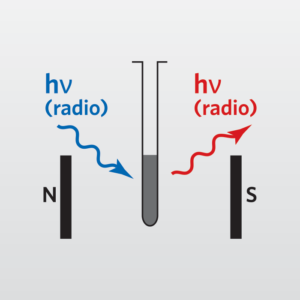Nuclear Magnetic Resonance Spectroscopy (NMR)
Home » Our Techniques » Spectroscopy » NMR
Nuclear Magnetic Resonance (NMR) Spectroscopy is a powerful analytical technique that can reveal structural information about many organic and inorganic molecules. In NMR, magnetic nuclei of specific isotopes are aligned by a strong external magnet and then perturbed by a radio wave. This external energy applied to the molecule is absorbed, and the perturbed nucleus is said to be “in resonance.” The resonance frequency is observed as re-emitted energy and is related to the identity, quantity, position and intra-molecular relationships occurring within the analyzed substance. Nuclei that have a spin quantum number of ½ typically give the best spectra – some of these nuclei are 1H, 13C, 19F, and 31P – all of which are available techniques at EAG.
At EAG, Nuclear Magnetic Resonance Spectroscopy is used to characterize polymers, lubricants, adhesives, surfactants, additives and custom-synthesized molecules. Samples are normally prepared in various deuterated solvents. Typical analysis times range from minutes to hours, depending on the nuclei being studied and the concentration of the sample. EAG’s analytical scientists are highly experienced and knowledgeable in complex spectrum interpretation, specialized 2D techniques (e.g. COSY, NOESY, DOSY, HMQC, HMBC, TOCSY, HSQC) and variable temperature NMR in order to address a wide variety of problems pertaining to a number of industries. Experience, fast turnaround, clear and concise written reports, and person-to-person service are provided to help customers resolve their analytical and technical challenges.

Ideal Uses of NMR
- Chemical structure identification
- Chemical composition analysis
- Raw materials fingerprinting
- Sample purity determination
- Quality assurance and control
- Compound identification and confirmation
- Quantitative analysis
- End group analysis of polymer
- Reaction kinetics examination
- Reaction mechanism investigation
Strengths
- Chemical shifts and J-couplings can provide specific chemical information
- Quantitative information
- Compositional information with mixtures
- Non-destructive method
- Small sample needed
- Wide range of temperature operation
Limitations
- Solubility in deuterated solvent is required
- The presence of diamagnetic, paramagnetic, or ferromagnetic ions causes spectral pattern to become broad, feature-less and uninformative
- Spectral interpretation requires an experienced scientist
- Sometimes data acquisition times are long (e.g. 13C is often run overnight)
NMR Technical Specifications
- Varian Mercury Plus 400 MHz, 5mm Auto Switchable (ASW) Probe with Pulsed Field Gradient (PFG) coil
- Signal Detected: Radio frequency
- Nuclei Detected: 1H, 13C, 19F, and 31P
- Operational Temperature: -80°C to 150°C
- Detection Limits: 0.1 – 0.5 wt.% (depending on the samples)
Would you like to learn more about using Nuclear Magnetic Resonance Spectroscopy?
Contact us today for your Nuclear Magnetic Resonance Spectroscopy (NMR) needs. Please complete the form below to have an EAG expert contact you.